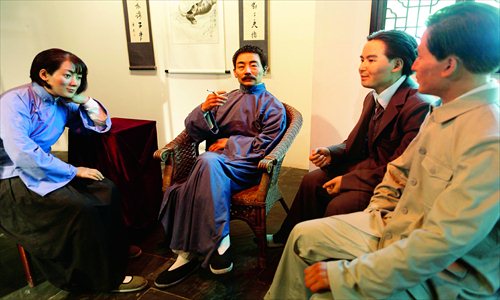Advocates decry tobacco exhibition

A sculpture of Lu Xun, the famous Chinese novelist (1881-1936), sits smoking in the China Tobacco Museum. Photo: CFP
Local health promotion authorities and health experts Tuesday accused the Tobacco Museum in Yangpu district of being a giant advertisement for the tobacco industry and demanded that authorities revoke its honorary titles as places to take students for patriotic and youth education.
The committee issued its demands in advance of World No Tobacco Day on May 31 and renewed its call for the public to ignore tobacco advertising, promotion and sponsorship, said Tang Qiong, vice director of the Shanghai Municipal Health Promotion Committee.
"The China Tobacco Museum is itself the tobacco industry's biggest advertisement," Tang said at an event Tuesday.
Prior to the event, the committee organized an unauthorized tour of the museum for 20 people, including reporters, tobacco control volunteers and health experts. The tour was cut short, however, after two museum employees and a security guard suggested the group leave the premises.
The museum has been under fire since the School of Public Health at Fudan University published a video and report last year criticizing the museum, according to a museum employee who said he participated in the planning of the museum. "The video was taken in secret. It contains some exaggerations and tries to demonize the tobacco industry," said the employee, who declined to give his name.
Zhen Pinpin, the Fudan University professor in charge of the report, offered evidence that it did not exaggerate the potential effects of the museum.
Her research team surveyed 59 university students before and after they toured the museum, she said. Over the course of the tour, the percentage of students who believed smoking was harmful to their health fell from 83.1 percent to 49.2 percent.
The museum's exhibitions feature photographs of famous leaders such as Mao Zedong, Deng Xiaoping, Jiang Zemin and Hu Jintao holding cigarettes or smelling tobacco leaves to demonstrate their support for the development of the tobacco industry.
"The museum tries to mislead visitors so they believe tobacco was an important companion to these people," said Ge Xin, a graduate student and volunteer who participated in the report.
In the past, the museum has hosted groups of visiting students. Last July, it was awarded honorary titles as a "patriotic education base," a "science education base," and a "juvenile education advanced unit." The honors came at a time when the tobacco industry had already shifted the target of its advertising more toward women and young people, said Zhu Jingfen, a public health expert from Shanghai Jiao Tong University.
In a survey of more than 30,000 juveniles from 2010 and 2012, researchers found a rapid increase in the youth smoking rate, Zhu said.
In the museum's defense, the unnamed employee reiterated that many early revolutionaries did have close relationships with the tobacco industry.
"Although the industry is in decline, more than 100 million Chinese people still make a living from tobacco or related industries. It will be a long time before the industry dies out," he said.